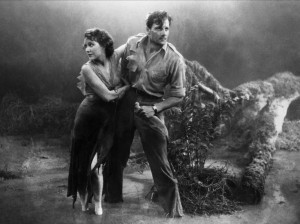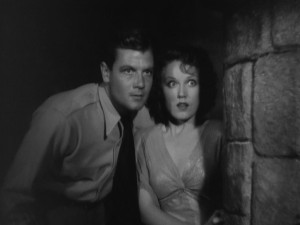#4 – The Most Dangerous Game (1932)
Director: Irving Pichel, Ernest B. Schoedsack
Writers: James Ashmore Creelman, Richard Connell (short story)
Cast: Joel McCrea, Leslie Banks, Fay Wray, Robert Armstrong, Noble Johnson
Cert: 12
Running time: 63mins
Year: 1932
Contemporary review:
“Banks grabs everything worth grabbing among performance honors. Fay Wray has no opportunity to be anything but decorative. With McCrea and Robert Armstrong (as a booze-guzzling simpleton) miscasting is evident.” – Variety, Dec 31st 1931
Electric Shadows rating: 
The lowdown: Roaring RKO ripping yarn based on perhaps cinema’s most oft-filmed story. Shot during pre-production of RKO’s other jungle epic, King Kong (released a year later), Kong devotees will notice both familiar looking sets and leading lady (Fay Wray). The plot, lifted from Richard Connell’s irresistible 8,000 word story, has solid lead Joel McCrea shipwrecked on a Pacific island, where he soon discovers he will be hunted for sport by villain Leslie Banks. Perfectly paced at a whisker over an hour, this is arguably the grandfather of every action movie made since.
The full verdict: If The Most Dangerous Game’s premise is not cinema’s most filmed plot, it must be beaten only by “boy meets girl”. And this film has boy meets girl, and a mad Cossack Count intent on hunting boy to death and raping girl as his reward.
Yes, this was one of Hollywood’s final films before the Hays Code really took hold.
Easy to see why Connell’s story has been so retold. Exciting and kinetic, it can be achieved on a small budget, taps into primal fears and makes room for critic-pleasing social commentary.
RKO’s official remake, 1945’s A Game of Death directed by Robert Wise, made the villain a Nazi-in-hiding. So too did Roy Boulting’s 1956 movie Run for the Sun, with Richard Widmark as the hero and Trevor Howard the villain.
1993’s Hard Target, 1994’s Surviving the Game and 2008’s New Town Killers used the man-as-prey device as sledgehammer commentary on the exploitation of society’s underclasses. Far cry away from Joel McCrea’s character here, Bob, an experienced big game hunter used to escorting the elite on safari.
Then there is the “countryside bites back” horror sub-genre big in the 1970s, where lethal yokels take revenge on city folk who are making their way of life obsolete. Examples include Deliverance (‘72), The Texas Chain Saw Massacre (’74), Rituals (’76), and The Hills Have Eyes (’77). Occasionally the theme is resurrected as in 1986’s Deliverance rip-off Hunter’s Blood.
Southern Comfort (1981) uses the device as a critique on America’s involvement in Vietnam with Louisiana swamp folk standing in for the Vietcong, while the story conceit was employed a year later as a comment on Vietnam veterans’ difficulty in returning to normal life in First Blood (1982).
It has also proved useful in satirising increasingly vicious demands of reality TV: see here The Running Man (1988), Series 7: The Contenders (2001), My Little Eye (2002), and Gamer (2009).
Any device where humans are seen as fleeing animals is ripe for a bit of social commentary on the modern world’s dehumanising effects on the young. For details check out, *SPOILERS*, Them (2006), King of the Hill (2007) and Eden Lake (2008).
The pressures of school or fears of entering an adult world are also articulated via The Most Dangerous Game’s central idea in Battle Royale (2000) and The Hunger Games (2011).
The storyline is so malleable you can even get a Schwarzenegger sci-fi classic out of it (Predator, ‘87), and a Schwarzenegger sci-fi stinker (The Running Man, ’87), in the same year. The plot has also been used as a a vehicle for WWE stars to show off their acting chops (Steve Austin’s The Condemned, 2008), a bargain basement video nasty (Turkey Shoot, 1982), and a kind-of advert for the Scottish tourist board (A Lonely Place to Die, 2011).
Plus episodes of The Incredible Hulk, The Simpsons, Criminal Minds, Relic Hunter, Get Smart, American Dad and Gilligan’s Island. And more…
Like many firsts of its kind, The Most Dangerous Game doesn’t get to the famous bit (i.e., the chase) until surprisingly late in the day, here 39 minutes into its 63 minute duration.
But, there is no flab or downtime in this lean thriller; all involved knew how to make movies for the masses.
Indeed director Ernest B. Schoedsack, writer James Ashmore Creelman, associate producer Merian C. Cooper and producer David O. Selznick, stars Fay Wray and Robert Armstrong, art director Thomas Little and composer Max Steiner all worked on King Kong to some degree while making this movie. Sets too were clearly reused for some timeless monkey business.
Opening with a philosophical discussion between McCrea’s Bob and Landers Stevens’ doctor on the moral dubiousness of hunting, Creelman’s dialogue foreshadows Bob’s third actor reversal from his day job, as he becomes the hunted.
A trap sinks the steamer Bob is aboard, realised with fine miniature work, and a shark attack later he is the sole survivor, washed up on the island. Here he stumbles across the home of Count Zaroff (Banks), a Cossack refugee who greets him with the memorable line, “Welcome to my poor fortress”.
The only other apparent residents in the house are the Odd Job-like valet-cum-muscleman Ivan (African-American actor Noble, “whited up” here in perhaps the first case of a black actor portraying a Caucasian), and drunken brother and tremulous sister Martin and Eve (Armstrong and Wray) whose ship was also mysteriously wrecked in the seas near the Count’s island.
Banks devours his role as the fiendish Count Zaroff. A World War I veteran whose injuries left half his face paralysed, Schoedsack famously framed him in profile for when the Count was behaving courteously and switched to full face shots to show Bank’s bulging left eye when his mask of sanity slipped.
Banks also chews over foreboding dialogue including this brilliantly concise insight into his mania:
“What I needed was not a new weapon, but a new animal… here on this island, I hunt the most dangerous game.”
Zaroff is the sadistic precedent of every genius psychopath since who masterminds cruel punishments for his own twisted reasons. Yet, audiences now only get a glimpse of his theatrical cruelty.
A lost scene featured him touring his “trophy room” with an aghast Eve and Bob. What survives is a human head mounted on the wall and another roiling in a pickling jar. Missing is a reportedly ten minute sequence of Zaroff showcasing his past kills; men now stuffed and forever fixed in the manner of their demise.
This so appalled early audiences that numerous walk-outs saw the sequence excised from all prints. Which makes Zaroff the Hannibal Lecter of his day, with this line from Michael Mann’s Manhunter deliciously appropriate:
“And how is Officer Stewart, the one who was first to see my basement… emotional problems I hear”.
Zaroff is a sexual sadist who uses killing as demented foreplay, making it clear he will “enjoy” Eve after defeating Bob – “Hunt first the enemy, then the woman”.
Absent from the original short story, Eve was added to the script to provide glamour and a love interest, and not much else in an underwritten role that requires Wray only to look wide-eyed in horror and scream convincingly.
Ironically, it is Bob who actually fulfils Zaroff’s credo of “First kill! Then love!” More ironically, it was Wray’s increasingly ripped and revealing wardrobe that got The Most Dangerous Game branded indecent and kept off cinema screens for a couple of decades in the US.
But, the climactic pursuit is what the film is best remembered for and director Schoedsack (co-director Pichel dealt with dialogue direction) conjures a thrilling, fever-pitched hunt through impressive jungle and swamp sets (with McCrea and Wray gingerly stepping passed an alligator at one point).
Resisting the urge to undercrank the camera to speed up the action, the film has its actors running full steam through treacherous canopy jungle, the camera either racing behind them, fixed in tight on their terrified/exhilarated faces, or slung low to capture the speed of the baying Hounds of Zaroff (an alternate title the movie was released under).
Now standard themes of the hunted becoming the hunter and the hero sacrificing civilised behavior to best his tormentor were freshly served here and contemporary audiences must have thrilled at the booby-traps Bob devises to halt the pursuing Zaroff.
One, involving a rigged log, was reused years later in Predator and the double bluff of the hero apparently perishing too is utilised by filmmakers wanting to pack a three-ring circus amount of excitement into one hour.
But, there was also social commentary to be had. Merian C. Cooper hated movies glamourising drunkenness. So Armstrong’s boorish soak soon realises the errors of his ways when he weaves into Zaroff’s trap with the slurred line: “Don’t worry, the Count’ll take care of me alright!”
Like the film’s title, that can be taken two ways…
Rob Daniel
Read Richard Connell’s original classic tale
Listen to Orson Welles’ radio adaptation of the original story
[youtube id=”1-swJzhDMaY”]








Pingback: Ready or Not here comes the year's best horror comedy
Pingback: What are Cinematic Greens? - Electric Shadows